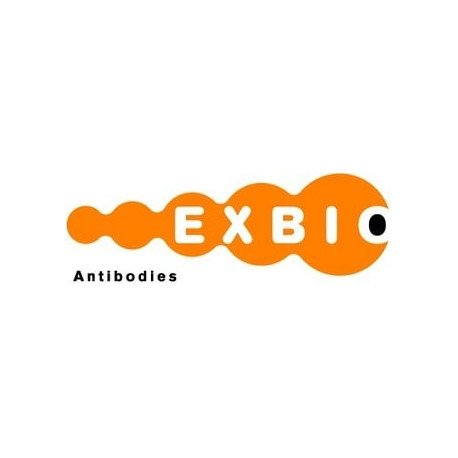Cart 0 Product Products (empty)
No products
To be determined Shipping
0,00 € Total
Prices are tax excluded
Product successfully added to your shopping cart
Quantity
Total
There are 0 items in your cart. There is 1 item in your cart.
Total products (tax excl.)
Total shipping (tax excl.) To be determined
Total (tax excl.)
Data sheet of Mouse Monoclonal to CD20
| Brand | Exbio |
| Product type | Primary antibodies |
| Reactivity | Human |
| Clonality | Monoclonal |
More info about Mouse Monoclonal to CD20
| Brand: | Exbio |
| Product no.: | 11-414-C025 |
| Product type: | Primary antibodies |
| Host species: | Mouse |
| Product name: | Mouse Monoclonal to CD20 |
| Antigen: | CD20 |
| Clonality: | Monoclonal |
| Clone: | LT20 |
| Isotype: | IgG2a |
| Immunogen: | Normal human lymphocytes from lymph node. |
| Format: | purified |
| Specificity: | The antibody LT20 reacts with CD20 (Bp35), a 33-37 kDa non-glycosylated membrane receptor with four transmembrane domains, expressed on B lymphocytes (it is lost on plasma cells), follicular dendritic cells, and at low levels on peripheral blood T lymphocytes. |
| Categories: | Calcium Signaling (Human), CD and Related Antigens (Human) |
| Concentration: | 1 mg/ml |
| Storage buffer: | Phosphate buffered saline (PBS) with 15 mM sodium azide, approx. pH 7.4 |
| Storage / stability: | Store at 2-8°C. Do not freeze. Do not use after expiration date stamped on vial label. |
| Background: | CD20 is a cell surface 33-37 (depending on the degree of phosphorylation) kDa non-glycosylated surface phosphoprotein expressed on mature and most malignant B cells, but not stem cells or plasma cells (low number of the CD20 has been also detected on a subpopulation of T lymphocytes and it can be expressed on follicular dendritic cells). Its expression on B cells is synchronous with the expression of surface IgM. CD20 regulates transmembrane calcium conductance (probably functioning as a component of store-operated calcium channel), cell cycle progression and B-cell proliferation. It is associated with lipid rafts, but the intensity of this association depends on extracellular triggering, employing CD20 conformational change and/or BCR (B cell antigen receptor) aggregation. After the receptor ligation, BCR and CD20 colocalize and then rapidly dissociate before BCR endocytosis, whereas CD20 remains at the cell surface. CD20 serves as a useful target for antibody-mediated therapeutic depletion of B cells, as it is expressed at high levels on most B-cell malignancies, but does not become internalized or shed from the plasma membrane following mAb treatment. |
| Purity: | > 95% (by SDS-PAGE) |
| Purification: | Purified by precipitation and chromatography |
| Product specific references: | *Kanderova V, Kuzilkova D, Stuchly J, Vaskova M, Brdicka T, Fiser K, Hrusak O, Lund-Johansen F, Kalina T: High-resolution Antibody Array Analysis of Childhood Acute Leukemia Cells. Mol Cell Proteomics. 2016 Apr;15(4):1246-61., VÅ¡ianská P, ŘÃhová L, Varmužová T, Suská R, Kryukov F, Mikulášová A, Kupská R, Penka M, Pour L, Adam Z, Hájek R: Analysis of B-cell subpopulations in monoclonal gammopathies. Clin Lymphoma Myeloma Leuk. 2015 Apr;15(4):e61-71., *Filatov AV, Krotov GI, Zgoda VG, Volkov Y: Fluorescent immunoprecipitation analysis of cell surface proteins: a methodology compatible with mass-spectrometry. J Immunol Methods. 2007 Jan 30;319(1-2):21-33., *Leukocyte Typing VII., Mason D. et al. (Eds.), Oxford University Press (2002)., *Teeling JL, Mackus WJ, Wiegman LJ, van den Brakel JH, Beers SA, French RR, van Meerten T, Ebeling S, Vink T, Slootstra JW, Parren PW, Glennie MJ, van de Winkel JG: The biological activity of human CD20 monoclonal antibodies is linked to unique epitopes on CD20. J Immunol. 2006 Jul 1;177(1):362-71. _x000D_ , *Polyak MJ, Deans JP: Alanine-170 and proline-172 are critical determinants for extracellular CD20 epitopes; heterogeneity in the fine specificity of CD20 monoclonal antibodies is defined by additional requirements imposed by both amino acid sequence and quaternary structure. Blood. 2002 May 1;99(9):3256-62. , *Chan HT, Hughes D, French RR, Tutt AL, Walshe CA, Teeling JL, Glennie MJ, Cragg MS: CD20-induced lymphoma cell death is independent of both caspases and its redistribution into triton X-100 insoluble membrane rafts. Cancer Res. 2003 Sep 1;63(17):5480-9. _x000D_ |
| General references: | *Li H, Ayer LM, Polyak MJ, Mutch CM, Petrie RJ, Gauthier L, Shariat N, Hendzel MJ, Shaw AR, Patel KD, Deans JP. The CD20 calcium channel is localized to microvilli and constitutively associated with membrane rafts: antibody binding increases the affinity of the association through an epitope-dependent cross-linking-independent mechanism. J Biol Chem. 2004 May 7;279(19):19893-901._x000D_ , *Glennie MJ, French RR, Cragg MS, Taylor RP: Mechanisms of killing by anti-CD20 monoclonal antibodies. Mol Immunol. 2007 Sep;44(16):3823-37._x000D_ , *Cragg MS, Walshe CA, Ivanov AO, Glennie MJ: The biology of CD20 and its potential as a target for mAb therapy. Curr Dir Autoimmun. 2005;8:140-74._x000D_ , *Petrie RJ, Deans JP: Colocalization of the B cell receptor and CD20 followed by activation-dependent dissociation in distinct lipid rafts. J Immunol. 2002 Sep 15;169(6):2886-91._x000D_ , *Hultin LE, Hausner MA, Hultin PM, Giorgi JV: CD20 (pan-B cell) antigen is expressed at a low level on a subpopulation of human T lymphocytes. Cytometry. 1993;14(2):196-204. |
| Related products: | - Mouse Monoclonal to CD205 - Mouse Monoclonal to CD200 - Mouse Monoclonal to CD203c |
| Shipping condition: | Room temperature |


